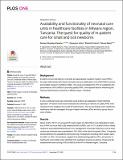| dc.contributor.author | Kamala, Serveus | |
| dc.contributor.author | Julius, Zamoyoni | |
| dc.contributor.author | Kosia, Efraim | |
| dc.contributor.author | Manzi, Fatuma | |
| dc.date.accessioned | 2023-11-09T08:12:23Z | |
| dc.date.available | 2023-11-09T08:12:23Z | |
| dc.date.issued | 2022-11-21 | |
| dc.identifier.uri | https://doi.org/10.1371/journal.pone.0269151 | |
| dc.identifier.uri | https://dspace.nm-aist.ac.tz/handle/20.500.12479/2421 | |
| dc.description | This research article was published in PLOS ONE, Vol 17, 2022. | en_US |
| dc.description.abstract | Background
Evidence shows that delivery of prompt and appropriate in-patient newborn care (IPNC)
through health facility (HF)-based neonatal care and stabilization units (NCU/NSUs) reduce
preventable newborn mortalities (NMs). This study investigated the HFs for availability and
performance of NCU/NSUs in providing quality IPNC, and explored factors influencing the
observed performance outcomes in Mtwara region, Tanzania.
Methods
A cross-sectional study was conducted using a follow-up explanatory mixed-methods
approach. HF-based records and characteristics allowing for delivery of quality IPNC were
reviewed first to establish the overall HF performance. The review findings were clarified by
healthcare staff and managers through in-depth interviews (IDIs) and focus group discus sions (FGDs).
Results
About 70.6% (12/17) of surveyed HFs had at least one NCU/NSU room dedicated for deliv ery of IPNC but none had a fully established NCUs/NSU, and 74.7% (3,600/4,819) of needy
newborns were admitted/transferred in for management. Essential medicines such as tetra cycline eye ointment were unavailable in 75% (3/4) of the district hospitals (DHs). A disparity
existed between the availability and functioning of equipment including infant radiant warm ers (92% vs 73%). Governance, support from implementing patterns (IPs), and access to
healthcare commodities were identified from qualitative inquiries as factors influencing the
establishment and running of NCUs/NSUs at the HFs in Mtwara region, Tanzania.
Conclusion
Despite the positive progress, the establishment and performance of NCUs/NSUs in provid ing quality IPNC in HFs in Mtwara region is lagging behind the Tanzania neonatal care
guideline requirements, particularly after the IPs of newborn health interventions completed
their terms in 2016. This study suggests additional improvement plans for Mtwara region
and other comparable settings to optimize the provision of quality IPNC and lower avoidable
NMs. | en_US |
| dc.language.iso | en | en_US |
| dc.publisher | PLOS ONE | en_US |
| dc.subject | Research Subject Categories::NATURAL SCIENCES | en_US |
| dc.title | Availability and functionality of neonatal care units in healthcare facilities in Mtwara region, Tanzania: The quest for quality of in-patient care for small and sick newborns. | en_US |
| dc.type | Article | en_US |

